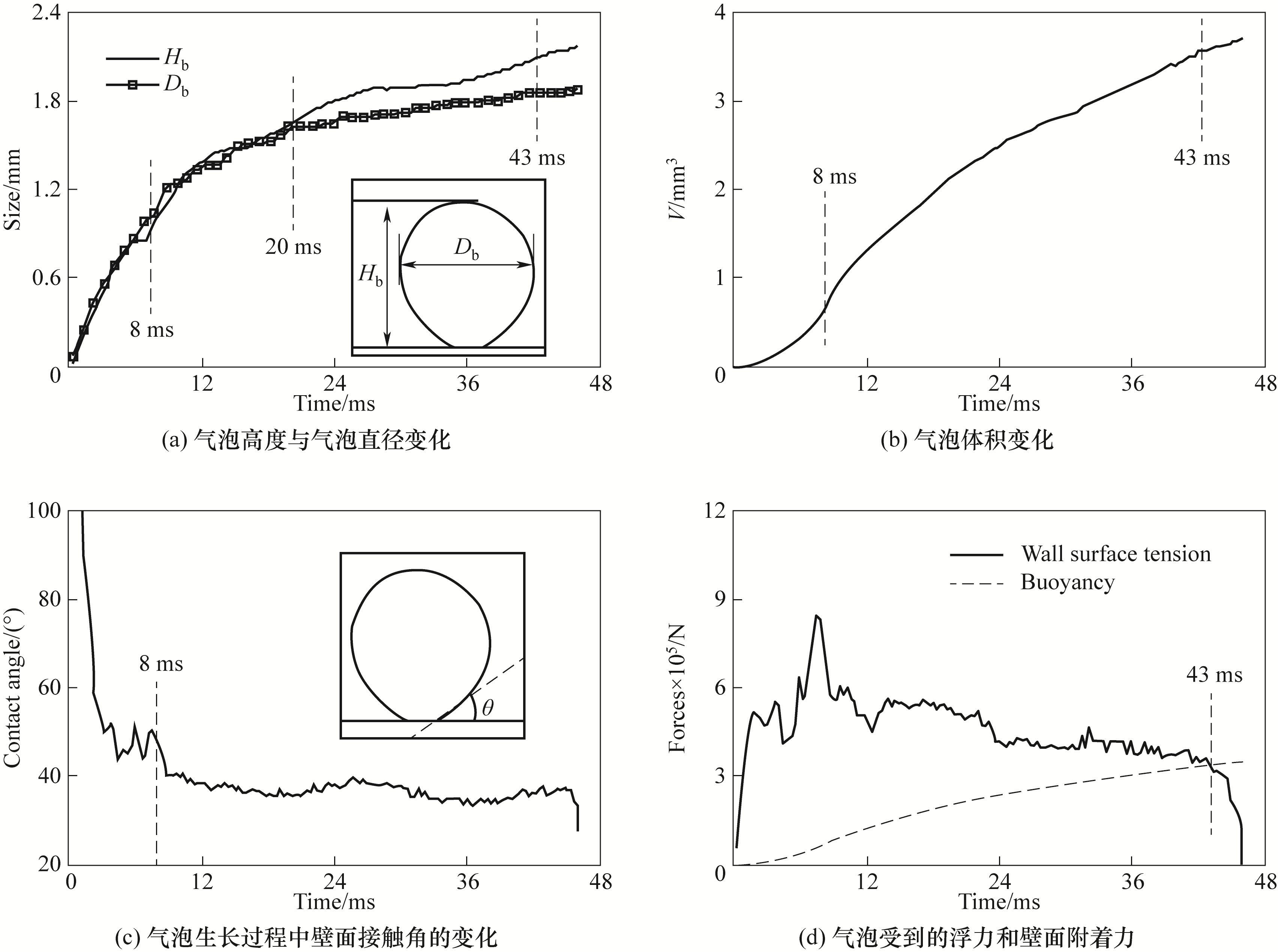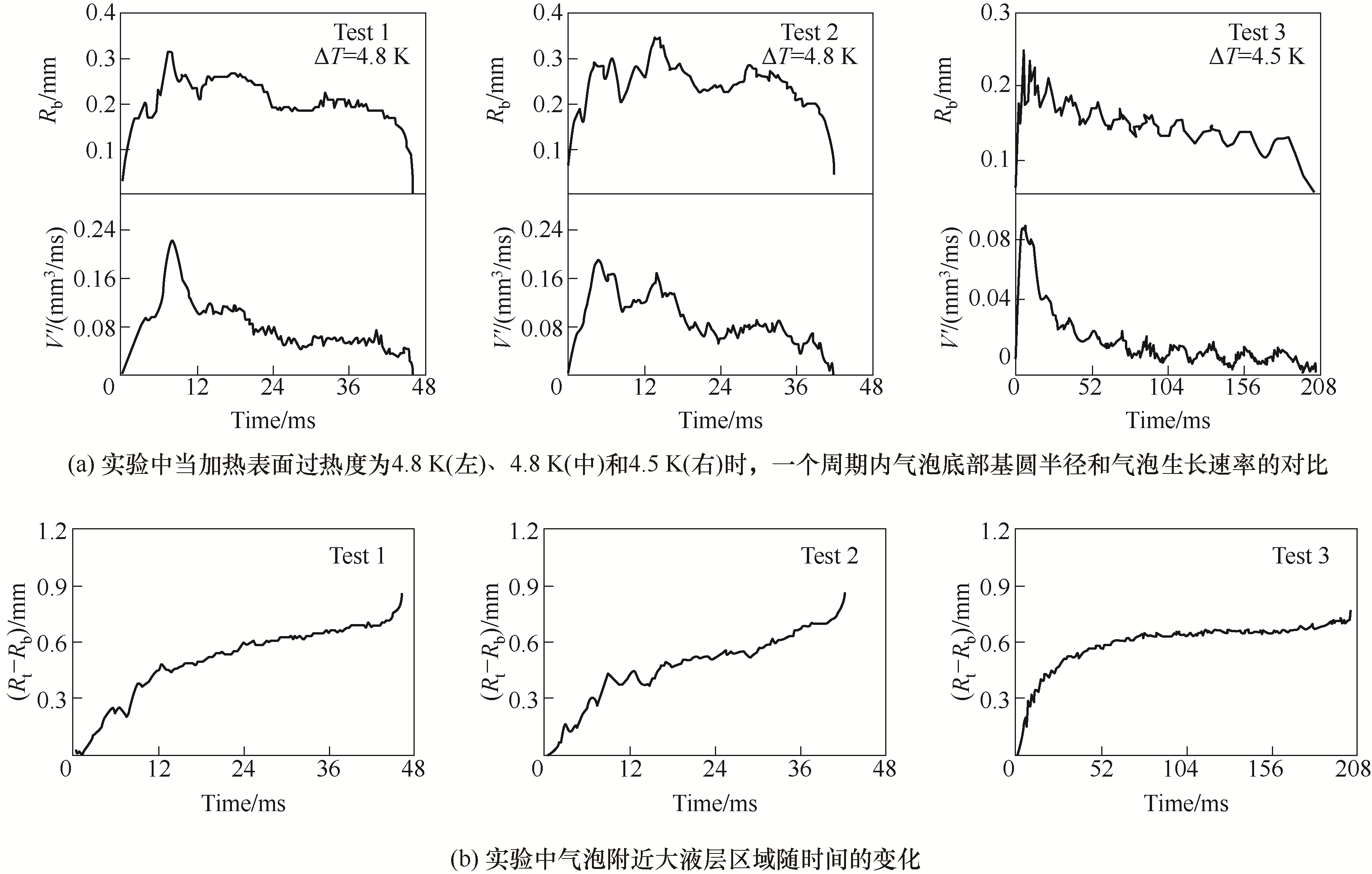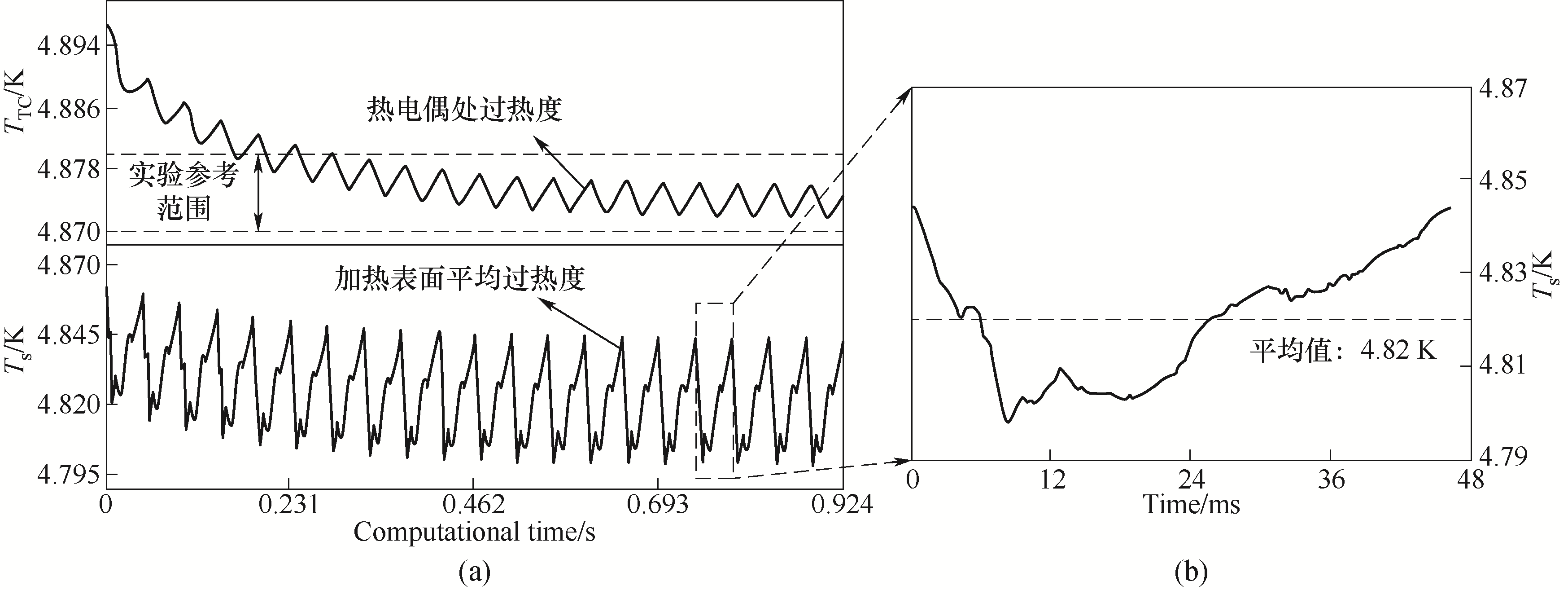化工学报 ›› 2021, Vol. 72 ›› Issue (5): 2514-2527.DOI: 10.11949/0438-1157.20201396
收稿日期:2020-10-09
修回日期:2021-01-11
出版日期:2021-05-05
发布日期:2021-05-05
通讯作者:
贺缨
作者简介:潘丰(1991—),男,博士研究生,基金资助:
PAN Feng( ),WANG Chaojie,MU Lizhong,HE Ying(
),WANG Chaojie,MU Lizhong,HE Ying( )
)
Received:2020-10-09
Revised:2021-01-11
Online:2021-05-05
Published:2021-05-05
Contact:
HE Ying
摘要:
微液层蒸发是沸腾过程中重要的换热机理。本文旨在通过单个气泡池沸腾实验中测得的气泡动态参数探究孤立气泡生长过程中加热表面的换热机理。首先通过沸腾池和加热表面的严格设计实现了单个气泡沸腾。进一步通过对孤立气泡生长时序图像的处理,得到了气泡在一个生长周期内气泡直径、纵横比以及气泡根部基圆半径的变化。对比发现,气泡生长速率与气泡根部基圆半径随时间的变化呈现显著正相关,而与大液层区域的变化相关程度较低,这表明微液层蒸发直接影响气泡体积变化,在孤立气泡沸腾过程中起主导作用。在此基础上进一步建立了加热表面换热过程的数值模型,基于实验中测得的气泡动态参数对气泡底层的微液层厚度进行了预测;通过多次迭代计算并匹配气泡生长速率和加热棒的温度发现,当表面过热度为4.82 K时,气泡底层微液层厚度约为3.43 μm,与相关文献中的微液层厚度测量值基本一致,进一步证实了微液层蒸发在孤立气泡沸腾换热过程中的重要性。本研究揭示了孤立气泡池沸腾过程中近壁面处的换热机制,为进一步的孤立气泡沸腾传热过程数值模拟奠定了理论基础。
中图分类号:
潘丰, 王超杰, 母立众, 贺缨. 池沸腾孤立气泡生长过程中微液层蒸发影响的实验和模拟耦合分析[J]. 化工学报, 2021, 72(5): 2514-2527.
PAN Feng, WANG Chaojie, MU Lizhong, HE Ying. Analysis of the influence of microlayer evaporation on single-bubble pool boiling by coupling the experimental observations and numerical simulations[J]. CIESC Journal, 2021, 72(5): 2514-2527.

图3 气泡轮廓提取流程以及所提取到的气泡轮廓与原始图像的对比
Fig.3 The extracting procedure of bubble outlines and the comparison of the obtained bubble outlines with the original images

图6 气泡生长过程中气泡高度、直径、体积、接触角以及浮力和表面张力随时间的变化(ΔT = 4.82 K)
Fig.6 The variations of bubble height, diameter, volume, contact angle, buoyancy and surface tension with time during the bubble growth period

图7 实验中测得的气泡生长速率、气泡底部基圆半径和大液层区域随时间的变化
Fig.7 Comparison of the bubble growth rates with the bubble root radii and macrolayer regions measured in the experiment

图13 加热表面及加热表面以下2.5 mm处过热度随时间变化的模拟结果(a)和一个周期内的加热表面过热度随时间的变化(b)
Fig.13 The simulated variations of the mean superheat on the heated surface and the local superheat at the position of 2.5 mm below the surface (a) and the mean superheat of heated surface within one bubble period (b)

图14 气泡生长过程中不同时刻加热表面过热度分布的模拟结果及气泡界面位置的实验结果
Fig.14 The superheat distributions of the heated surface in the simulation and the positions of bubble interface of the experiment at different moments
| 1 | Yaddanapudi N, Kim J. Single bubble heat transfer in saturated pool boiling of FC-72[J]. Multiphase Science and Technology, 2000, 12(3/4): 47-63. |
| 2 | Bankoff S G. Taylor instability of an evaporating plane interface[J]. AIChE Journal, 1961, 7(3): 485-487. |
| 3 | Cooper M G. The microlayer and bubble growth in nucleate pool boiling[J]. International Journal of Heat and Mass Transfer, 1969, 12(8): 915-933. |
| 4 | Das A K, Das P K, Saha P. Heat transfer during pool boiling based on evaporation from micro and macrolayer[J]. International Journal of Heat and Mass Transfer, 2006, 49(19/20): 3487-3499. |
| 5 | 柴立和, 彭晓峰, 王补宣. 池内核态沸腾换热新模型[J]. 化工学报, 2000, 51(5): 598-603. |
| Chai L H, Peng X F, Wang B X. New model for pool nucleate boiling heat transfer[J]. Journal of Chemical Industry and Engineering (China), 2000, 51(5): 598-603. | |
| 6 | de Yabuki T, Nakabeppu O. Heat transfer mechanisms in isolated bubble boiling of water observed with MEMS sensor[J]. International Journal of Heat and Mass Transfer, 2014, 76: 286-297. |
| 7 | Tange M, Ito M, Kobayashi K, et al. Heat flux partitioning of pool boiling in a confined space into flow field, liquid film thickness, and rewetting[J]. Thermal Science & Engineering, 2017, 25(4): 57-64. |
| 8 | Zou A, Chanana A, Agrawal A, et al. Steady state vapor bubble in pool boiling[J]. Scientific Reports, 2016, 6: 20240. |
| 9 | Sakashita H, Ono A, Nyui J. Critical heat flux and near-wall boiling behaviors in saturated and subcooled pool boiling on vertical and inclined surfaces[J]. Journal of Nuclear Science and Technology, 2009, 46(11): 1038-1048. |
| 10 | Höhmann C, Stephan P. Microscale temperature measurement at an evaporating liquid meniscus[J]. Experimental Thermal and Fluid Science, 2002, 26(2/3/4): 157-162. |
| 11 | Stephan P, Fuchs T, Wagner E, et al. Transient local heat fluxes during the entire vapor bubble life time[C]//Proceedings of the ECI International Conference on Boiling Heat Transfer. Florianópolis, Brazil, 2009: 919-928. |
| 12 | 陈宏霞, 孙源, 宫逸飞, 等. 单晶硅表面池沸腾可视化测量及数据分析[J]. 化工学报, 2019, 70(4): 1309-1317. |
| Chen H X, Sun Y, Gong Y F, et al. Visual measurement and data analysis of pool boiling on silicon surfaces[J]. CIESC Journal, 2019, 70(4): 1309-1317. | |
| 13 | 陈宏霞, 孙源, 肖红洋, 等. 微柱结构表面核态沸腾单气泡的数值模拟[J]. 化工进展, 2019, 38(11): 4845-4855. |
| Chen H X, Sun Y, Xiao H Y, et al. Numerical simulation of single bubble boiling on micro-pillar structure surface[J]. Chemical Industry and Engineering Progress, 2019, 38(11): 4845-4855. | |
| 14 | 牟帅, 赵长颖, 徐治国. 局部表面改性紫铜方柱阵列池沸腾传热特性和机理[J]. 化工学报, 2019, 70(4): 1291-1301. |
| Mou S, Zhao C Y, Xu Z G. Pool boiling heat transfer performance and mechanism of square copper pillar arrays with partially-modified surface[J]. CIESC Journal, 2019, 70(4): 1291-1301. | |
| 15 | Gong S J, Ma W M, Gu H Y. An experimental investigation on bubble dynamics and boiling crisis in liquid films[J]. International Journal of Heat and Mass Transfer, 2014, 79: 694-703. |
| 16 | Utaka Y, Kashiwabara Y, Ozaki M. Microlayer structure in nucleate boiling of water and ethanol at atmospheric pressure[J]. International Journal of Heat and Mass Transfer, 2013, 57(1): 222-230. |
| 17 | Koffman L D, Plesset M S. Experimental observations of the microlayer in vapor bubble growth on a heated solid[J]. Journal of Heat Transfer, 1983, 105(3): 625-632. |
| 18 | Gao M, Zhang L X, Cheng P, et al. An investigation of microlayer beneath nucleation bubble by laser interferometric method[J]. International Journal of Heat and Mass Transfer, 2013, 57(1): 183-189. |
| 19 | Jung S, Kim H. An experimental method to simultaneously measure the dynamics and heat transfer associated with a single bubble during nucleate boiling on a horizontal surface[J]. International Journal of Heat and Mass Transfer, 2014, 73: 365-375. |
| 20 | Kunkelmann C, Stephan P. CFD simulation of boiling flows using the volume-of-fluid method within OpenFOAM[J]. Numerical Heat Transfer, Part A: Applications, 2009, 56(8): 631-646. |
| 21 | 杜世元, 赵耀华. 薄液膜蒸发传热影响因素分析[J]. 化学工程, 2011, 39(4): 54-57, 64. |
| Du S Y, Zhao Y H. Analyses of factors affecting heat transfer in evaporating thin film region[J]. Chemical Engineering (China), 2011, 39(4): 54-57, 64. | |
| 22 | Bi J L, Vafai K, Christopher D M. Heat transfer characteristics and CHF prediction in nanofluid boiling[J]. International Journal of Heat and Mass Transfer, 2015, 80: 256-265. |
| 23 | Stephan P, Hammer J. A new model for nucleate boiling heat transfer[J]. Heat and Mass Transfer, 1994, 30(2): 119-125. |
| 24 | Jiang Y Y, Osada H, de Inagaki M, et al. Dynamic modeling on bubble growth, detachment and heat transfer for hybrid-scheme computations of nucleate boiling[J]. International Journal of Heat and Mass Transfer, 2013, 56(1/2): 640-652. |
| 25 | Sato Y, Niceno B. A depletable micro-layer model for nucleate pool boiling[J]. Journal of Computational Physics, 2015, 300: 20-52. |
| 26 | 王烨, 蔡杰进. 基于微液层模型的单汽泡生长数值模拟研究[J]. 原子能科学技术, 2018, 52(4): 600-606. |
| Wang Y, Cai J J. Numerical simulation of single bubble evolution based on microlayer model[J]. Atomic Energy Science and Technology, 2018, 52(4): 600-606. | |
| 27 | 程坤, 潘丰, 王超杰, 等. 狭窄加热表面上核态沸腾中汽泡合并特性的实验研究[J]. 工程热物理学报, 2019, 40(11): 2622-2631. |
| Cheng K, Pan F, Wang C J, et al. Experimental study of bubble coalescence behavior in nucleate boiling at a narrow heating surface[J]. Journal of Engineering Thermophysics, 2019, 40(11): 2622-2631. | |
| 28 | 陈汉梽, 姚远, 公茂琼, 等. 乙烷池内核态沸腾气泡脱离直径[J]. 化工学报, 2018, 69(4): 1419-1427. |
| Chen H Z, Yao Y, Gong M Q, et al. Experimental study on bubble departure diameter of ethane saturated nucleate pool boiling[J]. CIESC Journal, 2018, 69(4): 1419-1427. | |
| 29 | 刘维波, 张小鹏. 基础力学实验[M]. 大连: 大连理工大学出版社, 2011: 105-111. |
| Liu W B, Zhang X P. Mechanics Experiment[M]. Dalian: Dalian University of Technology Press, 2011: 105-111. | |
| 30 | Fuchs T, Kern J, Stephan P. A transient nucleate boiling model including microscale effects and wall heat transfer[J]. Journal of Heat Transfer, 2006, 128(12): 1257-1265. |
| 31 | Mukherjee A, Kandlikar S G. Numerical study of single bubbles with dynamic contact angle during nucleate pool boiling[J]. International Journal of Heat and Mass Transfer, 2007, 50(1/2): 127-138. |
| 32 | Pan F, Mu L, He Y, et al. A thermal-hydrodynamic coupling method for simulation of the interplay between bubble departure behavior and wall temperature variation in nucleate boiling [J]. Journal of Hydrodynamics, 2021, 33(2): 93-108. |
| 33 | Li Y X, Zhang K, Lu M C, et al. Single bubble dynamics on superheated superhydrophobic surfaces[J]. International Journal of Heat and Mass Transfer, 2016, 99: 521-531. |
| 34 | Giustini G, Jung S, Kim H, et al. Microlayer evaporation during steam bubble growth[J]. International Journal of Thermal Sciences, 2019, 137: 45-54. |
| 35 | 徐济鋆. 沸腾传热和气液两相流[M].北京:原子能出版社,2001: 220. |
| Xu J J. Boiling Heat Transfer and Two-phase Flow [M]. Beijing: Atomic Energy Press, 2001: 220. | |
| 36 | 赵耀华. 沸腾换热及临界热流的动态微液层模型[J]. 工程热物理学报, 2002, 23(S1): 85-88. |
| Zhao Y H. The dynamic microlayer model for nucleate boiling heat transfer and chf[J]. Journal of Engineering Thermophysics, 2002, 23(S1): 85-88. | |
| 37 | Heng Y, Mhamdi A, Wagner E, et al. Estimation of local nucleate boiling heat flux using a three-dimensional transient heat conduction model[J]. Inverse Problems in Science and Engineering, 2010, 18(2): 279-294. |
| 38 | 潘丰, 贺缨, 唐元梁. 加热表面粗糙度对高热流密度沸腾传热影响的多尺度数值模拟[J]. 工程热物理学报, 2016, 37(11): 2397-2408. |
| Pan F, He Y, Tang Y L. A multi-scale numerical study on the influence of surface roughness on high-flux nucleate boiling[J]. Journal of Engineering Thermophysics, 2016, 37(11): 2397-2408. |
| [1] | 晁京伟, 许嘉兴, 李廷贤. 基于无管束蒸发换热强化策略的吸附热池的供热性能研究[J]. 化工学报, 2023, 74(S1): 302-310. |
| [2] | 张化福, 童莉葛, 张振涛, 杨俊玲, 王立, 张俊浩. 机械蒸汽压缩蒸发技术研究现状与发展趋势[J]. 化工学报, 2023, 74(S1): 8-24. |
| [3] | 肖明堃, 杨光, 黄永华, 吴静怡. 浸没孔液氧气泡动力学数值研究[J]. 化工学报, 2023, 74(S1): 87-95. |
| [4] | 吴馨, 龚建英, 靳龙, 王宇涛, 黄睿宁. 超声波激励下铝板表面液滴群输运特性的研究[J]. 化工学报, 2023, 74(S1): 104-112. |
| [5] | 叶展羽, 山訸, 徐震原. 用于太阳能蒸发的折纸式蒸发器性能仿真[J]. 化工学报, 2023, 74(S1): 132-140. |
| [6] | 邵苛苛, 宋孟杰, 江正勇, 张旋, 张龙, 高润淼, 甄泽康. 水平方向上冰中受陷气泡形成和分布实验研究[J]. 化工学报, 2023, 74(S1): 161-164. |
| [7] | 张双星, 刘舫辰, 张义飞, 杜文静. R-134a脉动热管相变蓄放热实验研究[J]. 化工学报, 2023, 74(S1): 165-171. |
| [8] | 毕丽森, 刘斌, 胡恒祥, 曾涛, 李卓睿, 宋健飞, 吴翰铭. 粗糙界面上纳米液滴蒸发模式的分子动力学研究[J]. 化工学报, 2023, 74(S1): 172-178. |
| [9] | 陈爱强, 代艳奇, 刘悦, 刘斌, 吴翰铭. 基板温度对HFE7100液滴蒸发过程的影响研究[J]. 化工学报, 2023, 74(S1): 191-197. |
| [10] | 江河, 袁俊飞, 王林, 邢谷雨. 均流腔结构对微细通道内相变流动特性影响的实验研究[J]. 化工学报, 2023, 74(S1): 235-244. |
| [11] | 吴延鹏, 刘乾隆, 田东民, 陈凤君. 相变材料与热管耦合的电子器件热管理研究进展[J]. 化工学报, 2023, 74(S1): 25-31. |
| [12] | 袁佳琦, 刘政, 黄锐, 张乐福, 贺登辉. 泡状入流条件下旋流泵能量转换特性研究[J]. 化工学报, 2023, 74(9): 3807-3820. |
| [13] | 杨越, 张丹, 郑巨淦, 涂茂萍, 杨庆忠. NaCl水溶液喷射闪蒸-掺混蒸发的实验研究[J]. 化工学报, 2023, 74(8): 3279-3291. |
| [14] | 岳林静, 廖艺涵, 薛源, 李雪洁, 李玉星, 刘翠伟. 凹坑缺陷对厚孔板喉部空化流动特性影响研究[J]. 化工学报, 2023, 74(8): 3292-3308. |
| [15] | 王海, 林宏, 王晨, 许浩洁, 左磊, 王军锋. 高压静电场强化多孔介质表面沸腾传热特性研究[J]. 化工学报, 2023, 74(7): 2869-2879. |
| 阅读次数 | ||||||
|
全文 |
|
|||||
|
摘要 |
|
|||||
 京公网安备 11010102001995号
京公网安备 11010102001995号